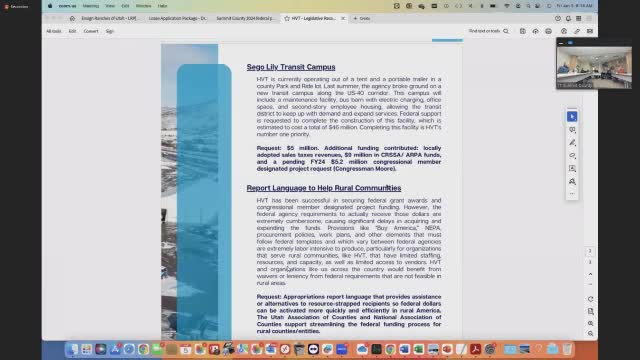High Valley Transit showcases innovative micro transit system to Colorado transportation authority
January 05, 2024 | Summit County Council, Summit County Commission and Boards, Summit County, Utah

This article was created by AI summarizing key points discussed. AI makes mistakes, so for full details and context, please refer to the video of the full meeting. Please report any errors so we can fix them. Report an error »

In a recent meeting of the Summit County Council, discussions centered around innovative transportation solutions and the challenges of securing federal funding for local projects. The atmosphere was charged with excitement as council members highlighted the success of High Valley Transit’s micro transit system, which has transported over two million riders in just two years. This system allows residents to summon a van via an app, providing direct transportation to bus stops or even specific destinations like hospitals. Such a model has garnered interest from transportation authorities in Colorado, who see it as a groundbreaking approach to public transit.
However, the council also faced the stark reality of navigating federal bureaucracy. While they have successfully secured federal grants, the requirements to access these funds are often cumbersome, leading to delays that hinder timely project execution. The council is advocating for changes in federal policy to ease these burdens, particularly for rural communities that may lack the resources to meet complex procurement standards.
As the council discussed upcoming spending bills, there was a sense of uncertainty regarding the fate of earmarks—specific funding requests that could support local initiatives. Council members expressed cautious optimism about retaining these earmarks, despite the unpredictable nature of federal budget negotiations. They urged local stakeholders to submit their requests promptly, emphasizing the importance of timely communication to maximize funding opportunities.
In addition to transportation, the council is also focusing on law enforcement needs. There is a push for funding to enhance digital forensics programs and replace aging patrol vehicles, reflecting a broader trend of congressional support for law enforcement initiatives. The council is keen to explore additional funding avenues to bolster public safety resources.
As the meeting concluded, it was clear that Summit County is at a pivotal moment, balancing innovative transportation solutions with the complexities of federal funding. The council's proactive approach and commitment to community needs signal a determination to navigate these challenges effectively, ensuring that residents continue to benefit from improved services and infrastructure.
However, the council also faced the stark reality of navigating federal bureaucracy. While they have successfully secured federal grants, the requirements to access these funds are often cumbersome, leading to delays that hinder timely project execution. The council is advocating for changes in federal policy to ease these burdens, particularly for rural communities that may lack the resources to meet complex procurement standards.
As the council discussed upcoming spending bills, there was a sense of uncertainty regarding the fate of earmarks—specific funding requests that could support local initiatives. Council members expressed cautious optimism about retaining these earmarks, despite the unpredictable nature of federal budget negotiations. They urged local stakeholders to submit their requests promptly, emphasizing the importance of timely communication to maximize funding opportunities.
In addition to transportation, the council is also focusing on law enforcement needs. There is a push for funding to enhance digital forensics programs and replace aging patrol vehicles, reflecting a broader trend of congressional support for law enforcement initiatives. The council is keen to explore additional funding avenues to bolster public safety resources.
As the meeting concluded, it was clear that Summit County is at a pivotal moment, balancing innovative transportation solutions with the complexities of federal funding. The council's proactive approach and commitment to community needs signal a determination to navigate these challenges effectively, ensuring that residents continue to benefit from improved services and infrastructure.
View full meeting
This article is based on a recent meeting—watch the full video and explore the complete transcript for deeper insights into the discussion.
View full meeting

